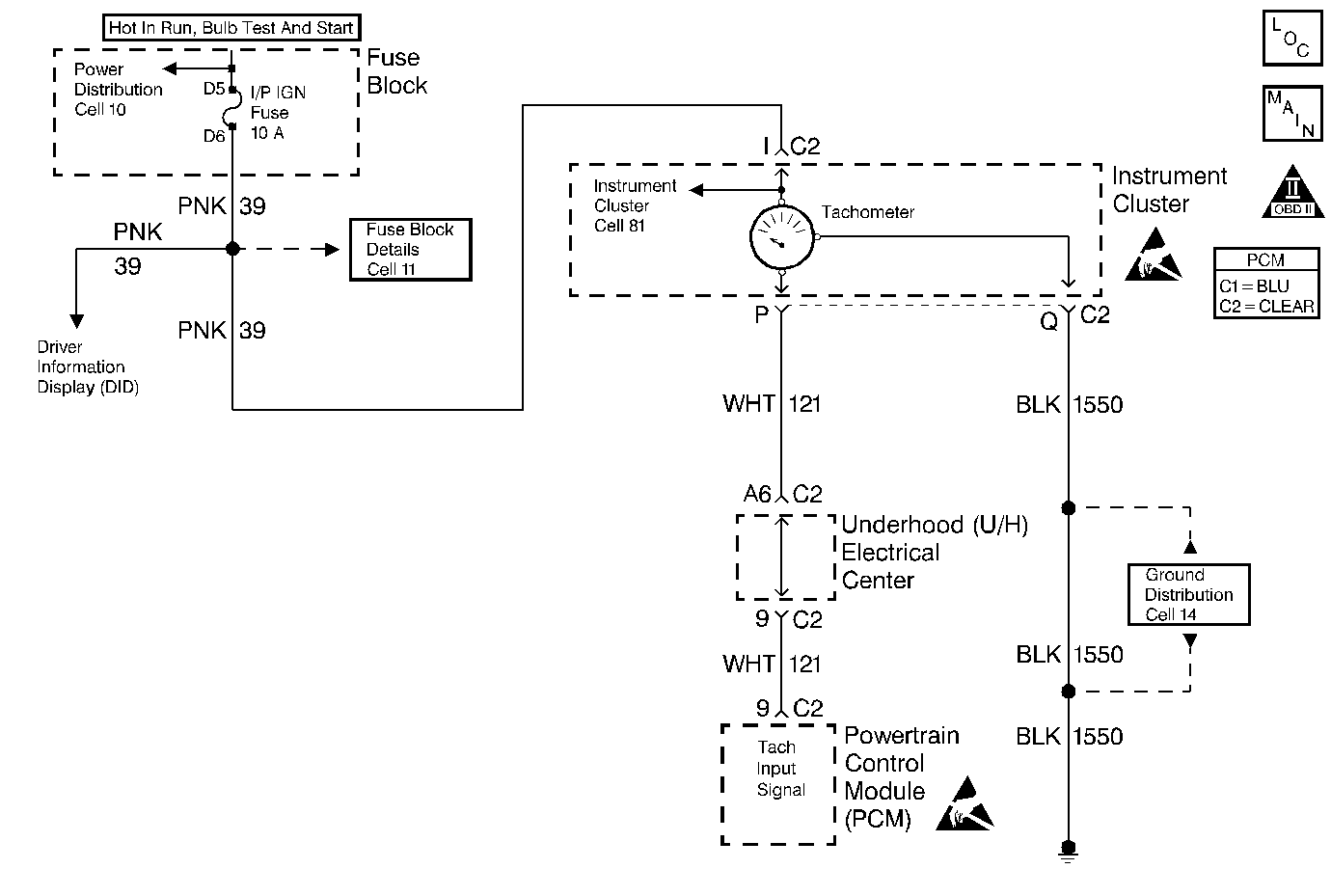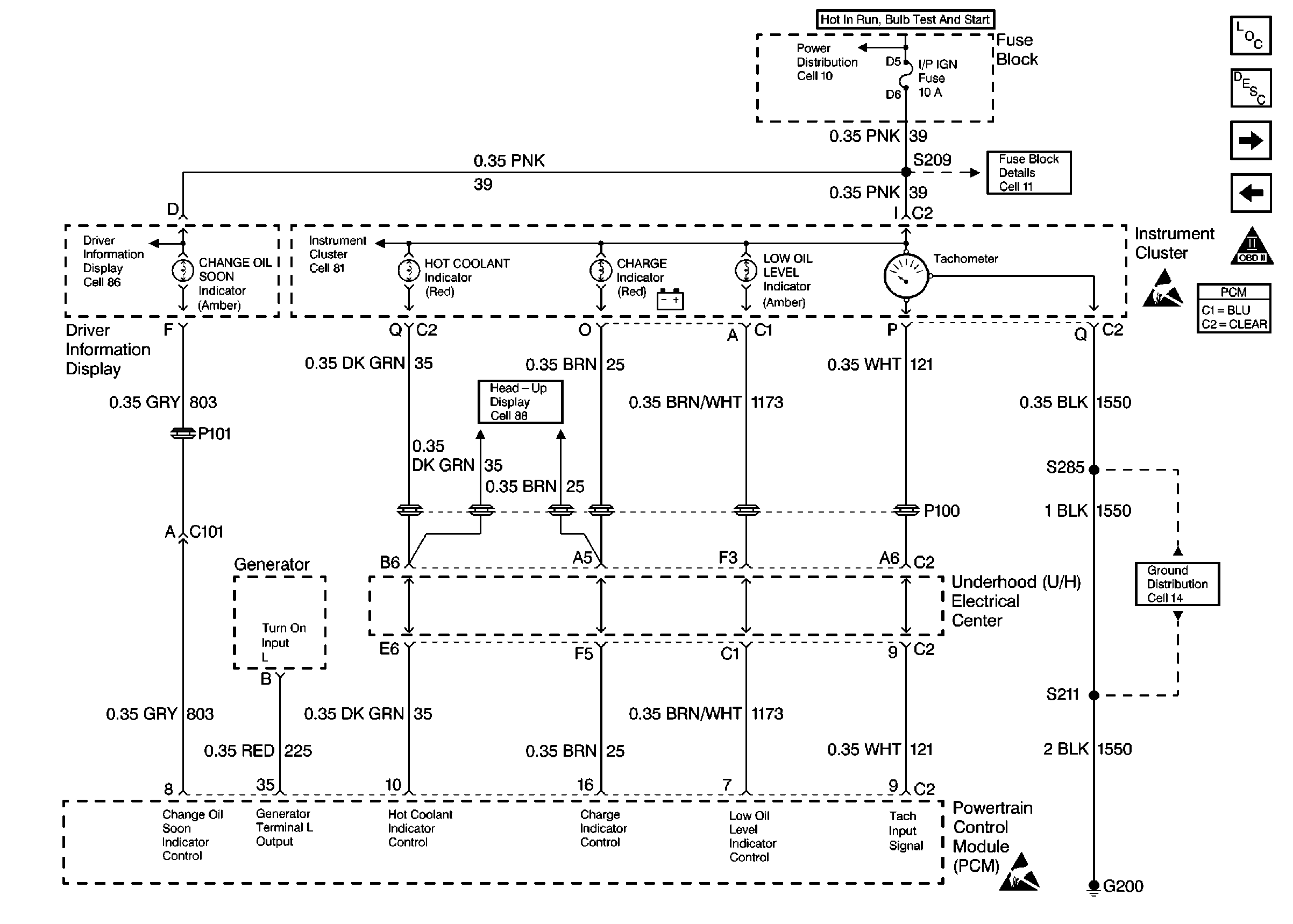Powertrain Control Module Controlled Warning Lamps Diagnosis Tachometer

Circuit Description
The PCM supplies the ground to energize the Instrument Cluster tachometer. When the ignition switch is first turned on the PCM grounds the tachometer circuit. The circuit will remain grounded until the PCM receives the first 24X reference pulse. Once the 24X reference pulse is received, the PCM controls the pulse frequency in relationship to engine RPM. The tachometer is controlled at a rate of two pulses per crankshaft revolution.
Diagnostic Aids
Refer to Instrument Cluster in Electrical Diagnosis for additional diagnostic information.
Check for the following conditions:
| • | Poor connection at the PCM or instrument cluster. Inspect harness connectors for backed out terminals, improper mating, broken locks, improperly formed or damaged terminals, and poor terminal to wire connection. |
| • | Damaged harness. Inspect the wiring harness for damage. If the harness appears to be OK, disconnect the PCM, turn the ignition ON and observe a voltmeter connected to the tachometer control circuit at the PCM harness connector while moving connectors and wiring harnesses related to the tachometer control circuit. A change in voltage will indicate the location of the fault. |
Test Description
Number(s) below refer to the step number(s) on the Diagnostic Chart.
-
Normally, ignition feed voltage should be present on the output driver circuit with the PCM disconnected and the ignition turned ON.
-
Checks for a shorted component or a short to B+ on the output driver circuit. Either condition would result in a measured current of over 0.5 amps.
-
Checks for a faulty instrument cluster.
-
A fault in the 24X/Camshaft position sensors feed or ground circuits will result in the loss of both PCM input pulses. Without a 24X reference pulse the PCM can not begin tachometer pulse control causing an inoperative tachometer.
-
This vehicle is equipped with a PCM which utilizes an Electrically Erasable Programmable Read Only Memory (EEPROM). When the PCM is being replaced, the new PCM must be programmed. Refer to PCM Replacement and Programming Procedures in Powertrain Control Module (PCM) and Sensors.
Step | Action | Value(s) | Yes | No | ||||||
|---|---|---|---|---|---|---|---|---|---|---|
1 | Was Instrument Cluster diagnosis in Electrical Diagnosis performed? | -- | Go to Instrument Cluster diagnosis in Electrical Diagnosis | |||||||
2 | Was the Powertrain On-Board Diagnostic System Check performed? | -- | Go to Powertrain On Board Diagnostic (OBD) System Check Powertrain OBD System Check | |||||||
Is voltage near the specified value? | B+ | |||||||||
Does the current reading remain less than the specified value? | 0.5 Amp | |||||||||
Is voltage at the specified value? | 0V | |||||||||
6 | Locate and repair short to voltage in the tachometer control circuit. Refer to Repair Procedures in Electrical Diagnosis. Is action complete? | -- | -- | |||||||
7 | Check the ignition feed fuse for the instrument cluster. Is the fuse blown? | -- | ||||||||
8 |
Is action complete? | -- | -- | |||||||
9 |
Is voltage near the specified value? | B+ | ||||||||
10 |
Was a problem found? | -- | ||||||||
11 |
Was a problem found? | -- | ||||||||
12 |
Does the test light flash ON and OFF? | -- | Refer to Diagnostic Aids | |||||||
13 | Is the test light on steady? | -- | ||||||||
Locate and repair the following circuit condition:
Is action complete? | -- | -- | ||||||||
15 |
Was a problem found? | -- | ||||||||
Locate and repair open in ignition feed circuit to the instrument cluster. Refer to Repair Procedures in Electrical Diagnosis. Is action complete? | -- | -- | ||||||||
17 | Replace the instrument cluster. Is action complete? | -- | -- | |||||||
18 | Replace the PCM. Important: Replacement PCM must be programmed. Refer to Powertrain Control Module Replacement/Programming PCM Replacement/Programmingfor procedures. Is action complete? | -- | -- | |||||||
19 | Operate the vehicle while observing the I/P tachometer. Does the I/P tachometer operate properly? | -- | System OK | Go to Instrument Cluster diagnosis in Electrical Diagnosis. |
Powertrain Control Module Controlled Warning Lamps Diagnosis Lamps
Refer to
Indicator Lamps

.
Circuit Description
The PCM controlled lamps are powered through the I/P IGN. The PCM turns ON the bulb, LED, or driver info center indicator by supplying a path to ground through the PCM.
Conditions which will illuminate each lamp are as follows:
| • | Change Oil Soon - The PCM will command the Change oil soon lamp on when the following conditions are met: |
| 1. | When the PCM determines that only 11% of the Oil Life is remaining. |
| 2. | The Change Oil Lamp will illuminate for about 1 minute. |
| • | Generator Lamp - The PCM supplies battery voltage to the generator's internal regulator (generator terminal L). When a fault in the Charging System occurs, the internal regulator grounds the L terminal voltage and the PCM commands the generator lamp ON. The PCM will command the generator lamp ON when the following condition(s) are present: |
| - | Engine speed is above 1200 RPM and system voltage is below 10 volts for at least 10 seconds. |
| - | The PCM detects a low voltage condition on the generator's L terminal for at least 10 seconds. |
| • | Hot Coolant Lamp - The PCM will command the hot coolant lamp on when engine coolant temperature rises above 124°C (255°F). The PCM will turn the hot coolant lamp OFF when engine coolant temperature decreases to below 121°C (248°F). |
Diagnostic Aids
A PCM controlled lamp ON at all times most likely indicates that a condition is present which requires the attention of the vehicle operator.
Check for the following conditions:
| • | Poor connection at PCM. Inspect harness connectors for backed out terminals, improper mating, broken locks, improperly formed or damaged terminals, and poor terminal to wire connection. |
| • | Damaged harness. Inspect the wiring harness for damage. If the harness appears to be OK, disconnect the PCM and turn the ignition ON . Observe a voltmeter connected to the affected PCM output circuit while moving connectors and wiring harnesses related to the PCM output circuit. A change in voltage will indicate the location of the fault. |
| • | Engine Oil Level Switch circuit: Use the Engine Oil Level Switch Diagnosis. |
Test Description
Number(s) below refer to the step number(s) on the Diagnostic Chart.
-
Normally, ignition feed voltage should be present on the output control circuit with the PCM disconnected and the ignition turned ON.
-
Checks for a shorted component or a short to B+ on the output control circuit. Either condition would result in a measured current of over 1.5 amps. Also checks for a component that is going open while being operated, resulting in a measured current of 0 amps.
-
Checks for a malfunctioning instrument cluster.
-
This vehicle is equipped with a PCM which utilizes an Electrically Erasable Programmable Read Only Memory (EEPROM). When the PCM is being replaced, the new PCM must be programmed.
Step | Action | Value(s) | Yes | No |
|---|---|---|---|---|
1 | Was the Powertrain On-Board Diagnostic (OBD) System Check performed? | -- | ||
2 | Was the Instrument Cluster System check in Electrical Diagnosis performed? | -- | Go to the Instrument Cluster System Check in Electrical Diagnosis | |
Is voltage near the specified value? | B+ | |||
Does the current reading remain between the specified values? | 0.05 Amp-1.5 Amps | |||
Is voltage at the specified value? | 0V | |||
6 | Locate and repair the short to voltage in the affected PCM output circuit. Refer to in Electrical Diagnosis. Is action complete? | -- | -- | |
7 | Check the fuse for the instrument panel cluster indicator lamps. Is the the fuse blown? | -- | ||
8 |
Is action complete? | -- | -- | |
9 |
Is voltage near the specified value? | B+ | ||
10 |
Was a problem found? | -- | ||
11 |
Was a problem found? | -- | ||
12 |
Does the test light flash ON and OFF? | -- | Refer to Diagnostic Aids | |
13 |
Was a problem found? | -- | ||
14 | Locate and repair open in the ignition feed circuit to the instrument panel cluster indicator lamps. Refer to Repair Procedures in Electrical Diagnosis. Is action complete? | -- | -- | |
15 | Replace the instrument panel cluster. Refer to On-Vehicle Service in Instrument Panel, Gages and Console. Is action complete? | -- | -- | |
Replace the PCM. Important: Replacement PCM must be programmed. Refer to Powertrain Control Module Replacement/Programming . Is action complete? | -- | -- | ||
17 | Operate the affected lamp using the scan tool output tests function. Does the affected lamp operate properly? | -- | System OK |
